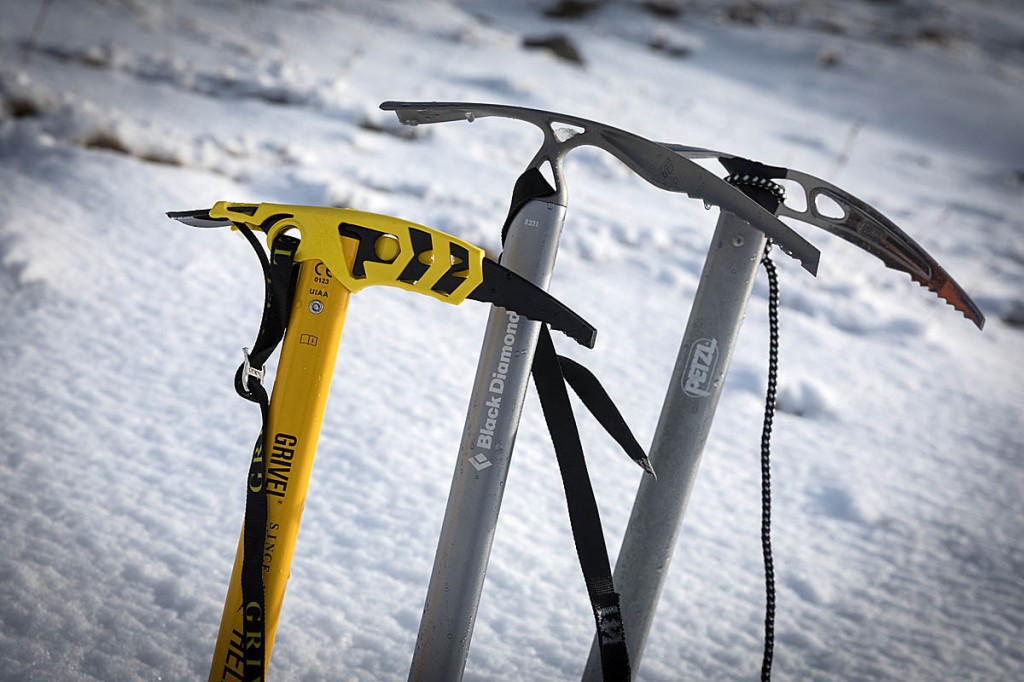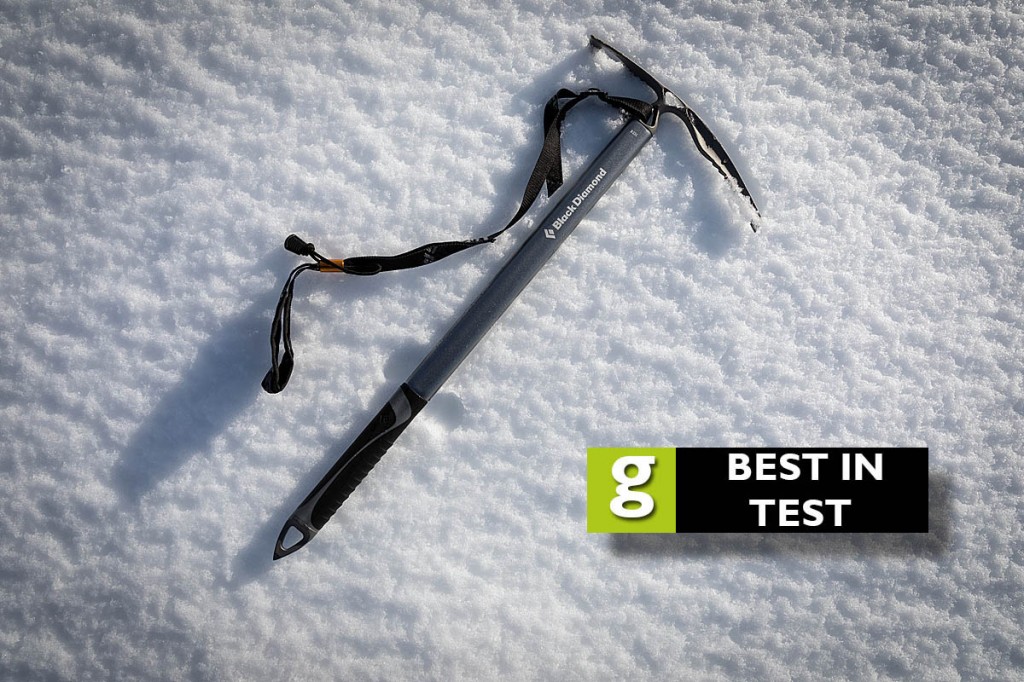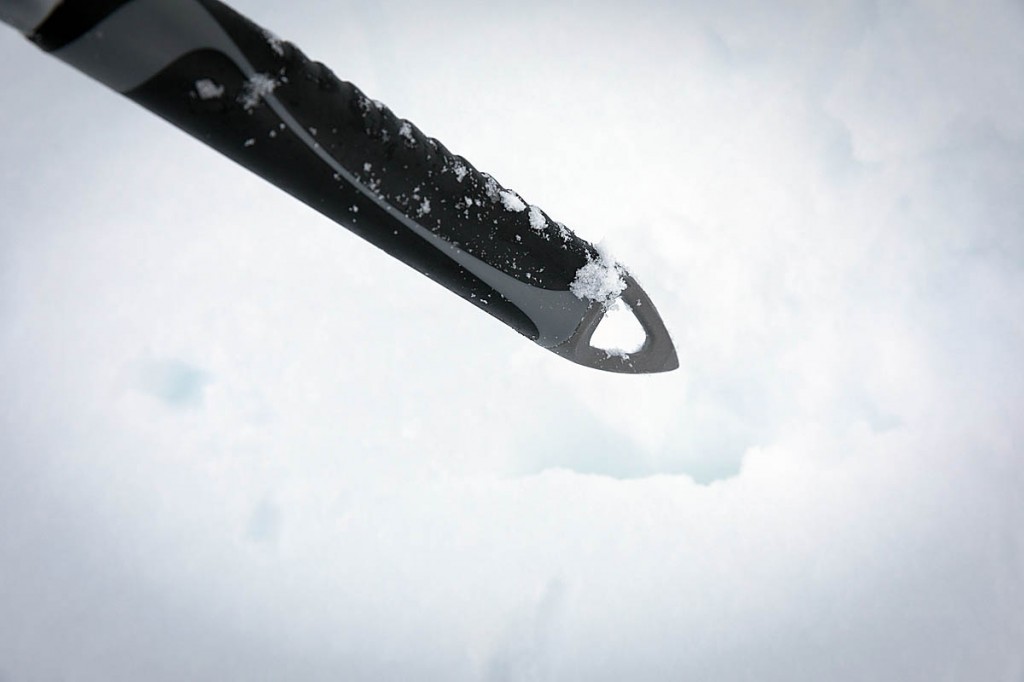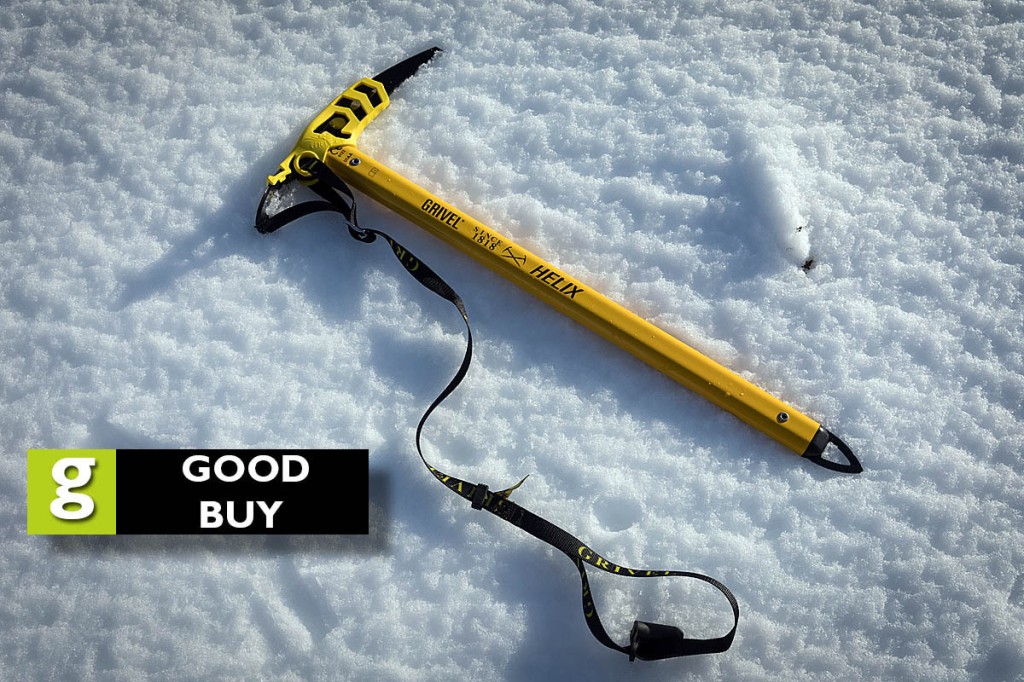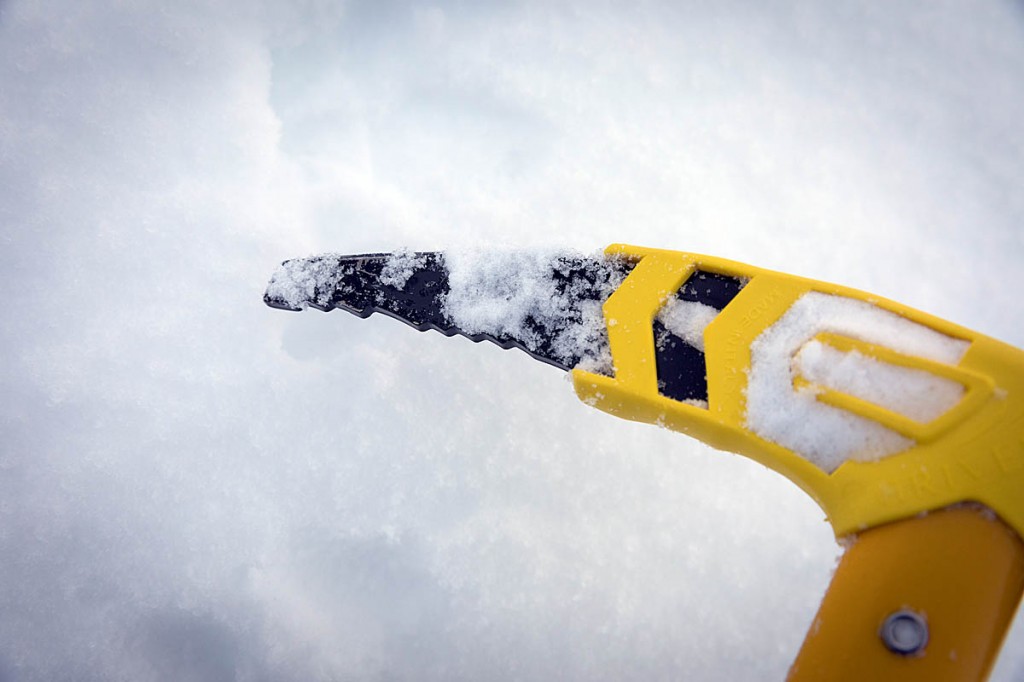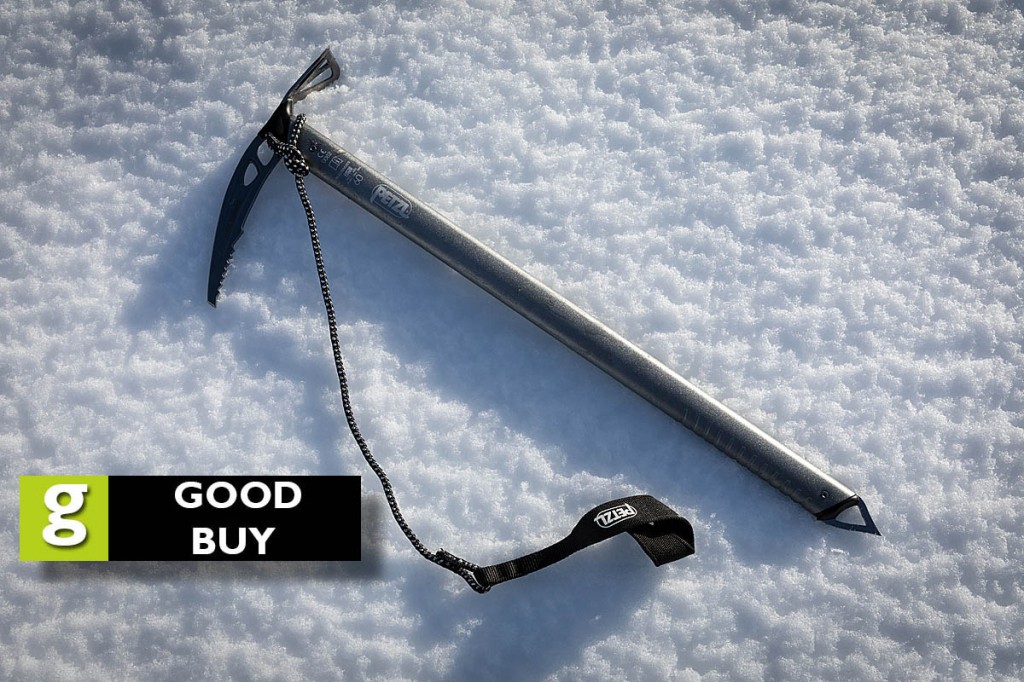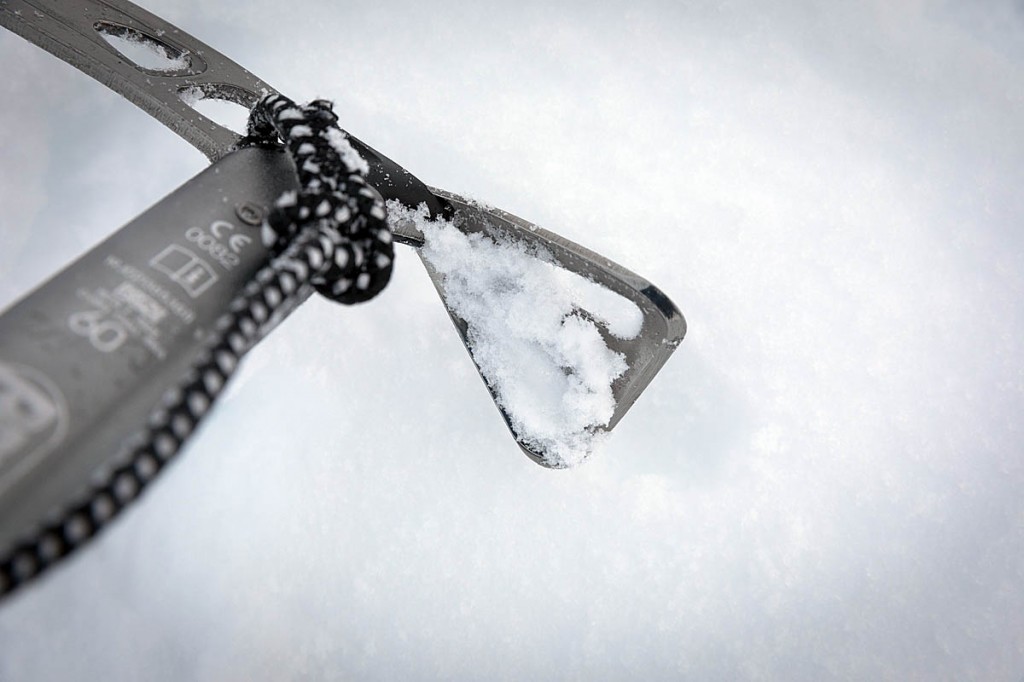An ice-axe is an essential piece of safety equipment for anyone wanting to walk during winter conditions on the UK’s mountains.
There’s no absolute definition of what constitutes winter conditions and it’s not defined by time of year. You could head for the hills on a mild December or January day and never encounter snow or ice. Conversely, you could find deep snow on the summit of Ben Nevis even in June.
Winter conditions mean you will have to cope with low temperatures, possibly frozen terrain, snow, ice, and probably winds and poor visibility.
So why carry an ice-axe? The principal use for a mountain walker is to self-arrest during a slip and slide. But the axe also provides stability, the ability to cut steps in ice and hard snow, and an aid to making progress on steeper ground.
The three axes in the test are what we would class as walkers’ ice-axes. They’re not designed for winter climbing, though they should cope with a fairly simple Grade I route. They are all rated B – basic, rather than T – the technical grade for climbing axes. They’re also a good choice for ski mountaineers who don’t need a climber’s axe. You’ll sometimes see these axes as designed for glacier crossings, though of course it’s unlikely you’ll encounter these in the UK.
It’s important you know how to use an ice-axe and the best way to gain that knowledge is on a winter-skills course, where it’s likely you’ll be taught the various methods of self-arrest during a slide; perhaps how to create a simple belay with your axe; the different methods of enhancing stability when moving on steeper ground plus, of course the vital skills of evaluating weather and avalanche risk.
None of the ice-axes in the test are designed for more technical techniques such as torqueing and are not suitable for tackling anything other than the lowest-grade, simple winter routes. But they are a necessity if you’re heading for the Scottish hills, the Snowdonia mountains or the Lake District fells when snow and ice prevail. There are even instances when an ice-axe might be useful in the Pennines or lesser ranges during a prolonged wintry period.
Walkers’ ice-axes are usually longer than climbing tools and usually come in a range of lengths, typically between 50cm and 75cm. The general advice is that, when standing in a normal upright position and holding the axe head with a straight arm, the spike should reach about the top of the boot or just above. Choose an axe that’s too long and you’ll find it less useful when plunging into harder snow using the uphill hand, which is the recommended method. It may also be more difficult to cover the spike with your hand when carrying out a self-arrest. Too short and you might find yourself stooping a little on steep slopes, which will induce a lessened stability.
All three of the axes in the test came with simple wrist leashes. This means that, when changing direction when zig-zagging up a slope, you have to swap the leash to the other wrist to continue with the axe in the uphill hand. This can slow progress a little and is an added annoyance. For this reason some hillgoers prefer to dispense with the leash and, if desired all our axes have leashes that can be detached.
However, if you consider that the ice-axe is a necessary piece of safety kit, losing it on a mountain slope could have serious consequences. For that reason, personally, I prefer to keep the leashes on. If the snow is deep and firm enough to hold the axe in place when the spike is plunged into it, I found the easiest method is to place the axe in the snow, swivel it 180 degrees and then swap the leash to the other wrist.
The four main components of an ice are: the shaft, the spike, the pick and the adze. The spike is found at the bottom of the shaft and is particularly useful for walkers’ ice-axes, pushed into snow and ice to allow the axe to be used as a sort of walking stick with added third-point of contact assurance to aid stability.
The shafts on the three test axes were all straight. All were made from aluminium.
The heads were all made from steel, a stronger material for the part of the axe likely to be subject to the highest impact. The pick is the pointed end of the head, with two main uses for a walker: self-arrest and driving into snow or ice to aid ascent.
The adze is the mini-hoe at the other end of the head, used for cutting steps in hard ice and neve or even constructing bucket seats or snow bollards when using ropes, though here we’re heading into climbing territory.
There will usually be a hole for passing a carabiner through in the head.
The three axes in the test all have classic, slightly down-turning picks.
Black Diamond Raven with Grip
£95
536g including leash
Rating: B
Country of manufacture: Taiwan
Lengths available: 55cm, 60cm, 65cm, 70cm, 75cm
Actual length tested: 61cm
The Black Diamond model was the longest and heaviest in the test, and has an aluminium shaft and stainless steel head. The pick is also the longest and is quite aggressive, with a fairly sharp tip and nine teeth. It has a scooped profile and matt finish, which aided grip a little.
The adze is a standard width, with a straight edge which cut into ice well. The spike is also fairly aggressive, with a tapered tip giving a good performance plunging into harder icy terrain.
The bottom section of the shaft has a rubberised grip, which was of most use when cutting steps while walking. It’s less likely to be used when walking and driving the pick into ice or hard snow, but if you’re progressing from walks to easier winter climbs, then the grip could be useful.
We wore gloves mostly while testing the axes but if you’re holding it with bare hands, the grip makes it warmer and less likely to slip.
The leash is well designed. It’s 1.6cm-wide webbing and is adjustable for length using a buckle. You need to ensure there’s at least 8cm excess for safety. The wrist loop is wide and has an adjustable slider for cinching it in. This has a cord and tab which were easy to use while wearing winter gloves.
The pick was very efficient at stopping a slide during self-arrest and the adze cut steps well. The beefier nature of the axe was evident while swinging for step cutting and particularly reaching up to use the pick on slopes. The point of balance of the axe was 19cm from its top.
The Raven also stood up well to standard knocks and scrapes during testing.
Performance: 45/50
Ease of use: 15/20
Features: 7/10
Quality: 9/10
Value for money: 7/10
Total score: 83/100
- The Black Diamond Raven with Grip was provided by Snow + Rock
Grivel Helix
£65
436g including leash
Rating: B
Country of manufacture: Italy
Lengths available: 53cm, 58cm, 66cm
Actual length tested: 53.5cm
The Helix is described by Grivel as an entry-level axe designed for occasional use and winter walking.
The model tested was the shortest in the test and, like the other two brands, has a straight aluminium shaft. The head is carbon steel.
The head is less aggressive, with a shorter pick and its seven teeth are more rounded and less sharp, as is the pick itself.
The angle of the pick is pretty straight and neutral. The adze is also a little more rounded and its bevelled edge less sharp. This made for a slightly more comfortable experience when pressing the adze against the shoulder during self-arrest but it was a bit less efficient in cutting steps in harder ice and névé. Swings and roundabouts.
One feature that did increase comfort is the unusual plastic handle fitted over the centre part of the head. This gives a softer feel when carrying the axe by its head which, for a walker, is probably going to be most of the time. It also gives a more insulated feel if not wearing gloves. If desired, the plastic cover can be slid off, once you have detached the leash, which passes through an aperture in the handle and the main body of the head.
The spike is also a little less aggressive but still went into harder snow with no difficulty.
The Grivel ice-axe has a 1.4cm-wide webbing wrist leash, adjustable for length. The wrist loop has a rubber slider to cinch it snugly. This was a little fiddly to adjust easily when wearing gloves. A useful feature is the rubber spike protector which is threaded on to the wrist loop and prevents the protector being lost. The rubber cap slides on to the spike when not in use to reduce the risk of injury.
The lighter head and shorter length of the Helix made for a comfortable swing when driving the pick into ice or cutting steps with the adze. Balance point for the axe is 16cm from the top of the head.
The Grivel axe is a good basic walker’s tool with a couple of nice design touches. The plastic overlay on the head makes it comfortable to carry on longer winter mountain walks, and the addition of a captures spike protector is useful.
Quality was good.
Performance: 43/50
Ease of use: 14/20
Features: 8/10
Quality: 9/10
Value for money: 8/10
Total score: 82/100
Petzl Glacier
£74
372g including leash
Rating: B
Country of manufacture: France
Actual length tested: 60cm
Lengths available: 60cm, 68cm, 75cm
The Glacier is described, as per its name, as being designed for glacier travel which, in UK terms, equates to winter mountain walking in Scotland, the Lake District, Snowdonia or even on lower hills when frozen conditions dictate.
The shaft is a straight design in anodised aluminium, with a series of machined indentations near the bottom to aid grip. The head is heat-treated steel, with the pick having a slight downturn. The spike is stainless steel and has a sharp, quite aggressive point.
The pick is moderately aggressive, with a double bevel on the pick end, and seven teeth. The adze is again medium in its edge, with a straight bevelled centre section and rounded corners.
The wrist leash is a 6mm-diameter kernmantle construction, with a webbing wrist loop with a wider lined section, which was comfortable. The leash length can only be adjusted by increasing the size of the rope loop passing through the head of the axe.
The pick was fairly long and bit into the snow well when performing a self-arrest. The adze didn’t feel too uncomfortable against the shoulder during the operation. The pick was also good at penetrating hard snow and ice to provide an anchor. The pick worked well when using the axe to anchor the walker when negotiating steeper ground.
The Glacier was the lightest axe in the test and, when swinging the head to use the pick on terrain above, it felt well balanced. Similarly, cutting steps felt good with the Petzl axe, and the adze was marginally the most efficient at cutting in to snow and ice. The balance point of the axe was 18.5cm from the top of the head.
The machined indentations helped a little when gripping the axe shaft, particularly with damp gloves.
The Petzl axe worked well as a general hillwalking tool. Its light weight, despite its length, was an advantage, but the Glacier still felt robust.
Quality was good.
Performance: 44/50
Ease of use: 15/20
Features: 7/10
Quality: 9/10
Value for money: 7/10
Total score: 82/100
All three of the ice-axes tested will serve the mountain walker or ski mountaineer well. They’re straightforward in design, with all the main safety areas working adequately on walking routes and moderately steeper slopes.
They all have what’s necessary to provide simple anchors or cut steps if need be, and all come with a simple leash. Depending on whether you want to use it or not, each was detachable.
For the important self-arrest, all worked well. There wasn’t a lot to choose between them, but the Black Diamond Raven with Grip just pipped the other two on performance, and has enough aggression in its surfaces to allow a move on to grade I routes.
ac
The Grivel Helix is competitively priced, and the Petzl Glacier’s lighter weight will save a few grams on what’s likely to be an increased pack load on winter ascents.
Quality was good in all of them, and all have satisfied the appropriate tests of general, category B ice-axes. Although the Black Diamond was marginally the best performer, it was also the most expensive. We can recommend all three of the models in the test.
We need to emphasise that carrying an ice-axe and wearing crampons is not enough; you need to be able to use them, preferably after undertaking a thorough course in winter safety.
- The ice-axes were supplied by the brands except where indicated
